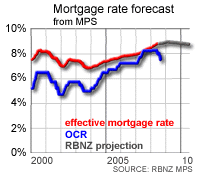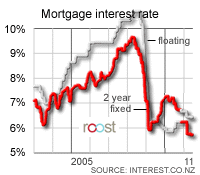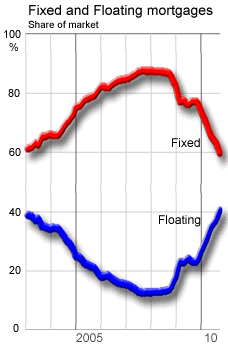 It's still early days, but the initial signs are that only half the Reserve Bank's surprisingly large 50 basis point cut in the OCR is being passed on to the largest chunk of mortgage borrowers, those on fixed rate mortgages. (Updated to include announcements from Westpac, ANZ and National).
It's now clear why the Reserve Bank went for a 50 basis point cut rather than a 25 basis point cut. It's possible a 25 basis point cut would have resulted in no cut in fixed mortgage rates.
The headlines looked great yesterday. Kiwibank cut its variable mortgage rate by 50 basis points within 90 minutes of the announcement. ASB, BNZ and Westpac followed with press releases announcing their 50 basis point cuts in their variable rates by the end of the day. Less prominent in the coverage was what they were doing to both their fixed mortgage rates and their deposit rates.
It's still early days, but the initial signs are that only half the Reserve Bank's surprisingly large 50 basis point cut in the OCR is being passed on to the largest chunk of mortgage borrowers, those on fixed rate mortgages. (Updated to include announcements from Westpac, ANZ and National).
It's now clear why the Reserve Bank went for a 50 basis point cut rather than a 25 basis point cut. It's possible a 25 basis point cut would have resulted in no cut in fixed mortgage rates.
The headlines looked great yesterday. Kiwibank cut its variable mortgage rate by 50 basis points within 90 minutes of the announcement. ASB, BNZ and Westpac followed with press releases announcing their 50 basis point cuts in their variable rates by the end of the day. Less prominent in the coverage was what they were doing to both their fixed mortgage rates and their deposit rates.
 ASB cut its key 2 year mortgage rate by just 5 basis points to 8.9%. Kiwibank cut its 2 year fixed mortgage special rate (available to those with at least 20% equity) by 36 basis points to 8.49%. BNZ cut its 2 year mortgage rate by 30 basis points to 8.79%. Westpac cut its fixed mortgage rates by 5-25 basis points, but cut its term deposit rates by 20-45 basis points.
ANZ and National cut their variable rates by 50 basis points too, but cut their fixed rates by 20 to 50 basis points. They cut their key 2 year rate by 25 basis points to 8.70%.
So why are the banks not passing it all on? The big ones have borrowed NZ$135 billion overseas to lend cheaply in the past to New Zealand home buyers and the interest charges on that foreign debt have increased significantly in the last 14 months since the advent of the Credit Crunch, triggered by the sub-prime mortgage debacle in the United States.
Foreign lenders are much more cautious about lending generally and the "spreads" or margins between inter-bank borrowing and the safest type of government debt has widened by anything from 150 to 250 basis points, depending on the term of the debt.
If those higher foreign borrowing costs are not passed on in full to New Zealand borrowers then the banks' profits fall. They can soften the profit hit by reducing their term deposit rates by even more than they cut mortgage rates, which the banks have done a little, or by reducing other costs or increasing bank fees. It is interesting that Westpac cut its term deposit rates but not its fixed mortgage rates. Banks are finding it easier to cut term deposit rates because of the 'flight to quality' going on right now after the recent spate of finance company collapses.
So far the Reserve Bank's OCR cut has done little to cut the effective mortgage rates paid by much because of the sheer weight of the fixed mortgage book and the higher international funding costs that are being passed on at the same time.
Obviously, those on fixed rates that don't mature for a while do not get a lower rate. Those who fixed two or three years ago and are due to refix now will actually see their interest rate rise from around 8% to around 8.5%.
ASB cut its key 2 year mortgage rate by just 5 basis points to 8.9%. Kiwibank cut its 2 year fixed mortgage special rate (available to those with at least 20% equity) by 36 basis points to 8.49%. BNZ cut its 2 year mortgage rate by 30 basis points to 8.79%. Westpac cut its fixed mortgage rates by 5-25 basis points, but cut its term deposit rates by 20-45 basis points.
ANZ and National cut their variable rates by 50 basis points too, but cut their fixed rates by 20 to 50 basis points. They cut their key 2 year rate by 25 basis points to 8.70%.
So why are the banks not passing it all on? The big ones have borrowed NZ$135 billion overseas to lend cheaply in the past to New Zealand home buyers and the interest charges on that foreign debt have increased significantly in the last 14 months since the advent of the Credit Crunch, triggered by the sub-prime mortgage debacle in the United States.
Foreign lenders are much more cautious about lending generally and the "spreads" or margins between inter-bank borrowing and the safest type of government debt has widened by anything from 150 to 250 basis points, depending on the term of the debt.
If those higher foreign borrowing costs are not passed on in full to New Zealand borrowers then the banks' profits fall. They can soften the profit hit by reducing their term deposit rates by even more than they cut mortgage rates, which the banks have done a little, or by reducing other costs or increasing bank fees. It is interesting that Westpac cut its term deposit rates but not its fixed mortgage rates. Banks are finding it easier to cut term deposit rates because of the 'flight to quality' going on right now after the recent spate of finance company collapses.
So far the Reserve Bank's OCR cut has done little to cut the effective mortgage rates paid by much because of the sheer weight of the fixed mortgage book and the higher international funding costs that are being passed on at the same time.
Obviously, those on fixed rates that don't mature for a while do not get a lower rate. Those who fixed two or three years ago and are due to refix now will actually see their interest rate rise from around 8% to around 8.5%.
 The Reserve Bank measures the effective interest rate paid by homeowners, taking into account the fact that 87% of all mortgages are fixed rate mortgages. Its figures show that NZ$52.3 billion worth of mortgages are due to roll over in the next year and that chunk has an effective rate of 8.49%.
The Reserve Bank estimates the effective mortgage rate for the entire stock of mortgages at around 8.8% at the moment. As the chart at the top shows, the Reserve Bank is actually forecasting that the effective mortgage rate will rise to 9.0% by February 2009 and stay around there for the rest of 2009 before easing back to 8.7% by July 2010.(Updated to include September MPS forecast)
That says the OCR cut yesterday was all about stopping the effective mortgage rate from rising, not making it fall.
That's because the Reserve Bank does not see those international funding costs dropping. They may even increase.
The implication of these forecasts is extraordinary. The Reserve Bank is forecasting the 90 day bill rate will drop to an average of 6.9% in 2011 from 8.6% in 2008. That's 170 basis points of monetary policy easing, yet the effective mortgage rate will drop just 10 basis points.
Essentially the Reserve Bank is saying that virtually none of its monetary policy easing will be passed on to mortgage borrowers in the next 3 years because of the dire state of international money markets and the need for banks to preserve their profit margins.
That also implies we are in for a long period of subdued economic growth, retail spending and house prices.
The Reserve Bank measures the effective interest rate paid by homeowners, taking into account the fact that 87% of all mortgages are fixed rate mortgages. Its figures show that NZ$52.3 billion worth of mortgages are due to roll over in the next year and that chunk has an effective rate of 8.49%.
The Reserve Bank estimates the effective mortgage rate for the entire stock of mortgages at around 8.8% at the moment. As the chart at the top shows, the Reserve Bank is actually forecasting that the effective mortgage rate will rise to 9.0% by February 2009 and stay around there for the rest of 2009 before easing back to 8.7% by July 2010.(Updated to include September MPS forecast)
That says the OCR cut yesterday was all about stopping the effective mortgage rate from rising, not making it fall.
That's because the Reserve Bank does not see those international funding costs dropping. They may even increase.
The implication of these forecasts is extraordinary. The Reserve Bank is forecasting the 90 day bill rate will drop to an average of 6.9% in 2011 from 8.6% in 2008. That's 170 basis points of monetary policy easing, yet the effective mortgage rate will drop just 10 basis points.
Essentially the Reserve Bank is saying that virtually none of its monetary policy easing will be passed on to mortgage borrowers in the next 3 years because of the dire state of international money markets and the need for banks to preserve their profit margins.
That also implies we are in for a long period of subdued economic growth, retail spending and house prices.
Banks cautious about passing on all of OCR cut to borrowers
Banks cautious about passing on all of OCR cut to borrowers
12th Sep 08, 11:49am
by

We welcome your comments below. If you are not already registered, please register to comment
Remember we welcome robust, respectful and insightful debate. We don't welcome abusive or defamatory comments and will de-register those repeatedly making such comments. Our current comment policy is here.